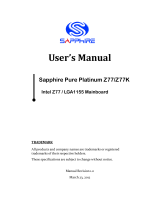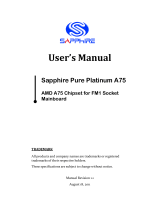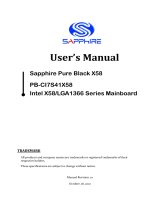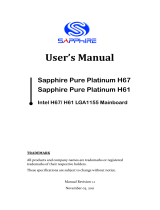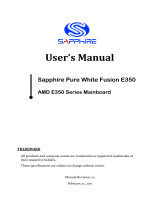Page is loading ...

User’s Manual
Sapphire Pure Black 990FX
AMD 990FX/SB950 for AM3b Socket Mainboard
TRADEMARK
All products and company names are trademarks or registered
trademarks of their respective holders.
These specifications are subject to change without notice.
Manual Revision 1.0
September 23, 2011

~ ii ~
Federal Communications Commission (FCC) Statement
This device has been tested and found to comply with the limits for a Class B
digital device, pursuant to Part 15 of FCC Rules. These limits are designed to
provide reasonable protection against harmful interference in a residential
installation. This equipment generates, uses and can radiate radio frequency
energy and, if not installed and used in accordance with instructions contained
in this manual, may cause harmful interference to radio and television
communications. However, there is no guarantee that interference will not occur
in a particular installation.
If this product does cause harmful interference to radio or television reception,
which can be determined by turning the equipment off and on, the user is
encouraged to try to correct the interference by one or more of the following
measures:
Reorient or relocate the receiving antenna.
Increase the separation between the equipment and receiver.
Connect the product into an outlet on a circuit different from that to which
the receiver is connected.
Consult the dealer or an experienced radio/TV technician for help.
Note1:
Connecting this device to peripheral devices that do not comply with Class
B requirements, or using an unshielded peripheral data cable, could also
result in harmful interference to radio or television reception
Note2: The user is cautioned that any changes or modifications not expressly
approved by the party responsible for compliance could void the user’s
authority to operate this product.
Note3: To ensure that the use of this product does not contribute to
interference, it is necessary to use shielded I/O cables
CE: Radiation of EN 55022 & Immunity of EN 55024
Waste Electrical and Electronic Equipment (WEEE) Statement
To protect the global environment, this product must be sent to separate collection
facilities for recovery and recycling.
DISPOSAL
Do not dispose of this product as unsorted municipal waste. Collect such
waste separately for special treatment.

~ iii ~
Table of Contents
Chapter 1 Introduction ..................................................................... 1
1-1 Mainboard Specifications .......................................................... 1
1-2 Package Contents ................................................................... 4
1-3 Mainboard Layout ................................................................... 5
Chapter 2 Installation ....................................................................... 9
2-1 Before You Begin .................................................................... 9
2-2 Installing the I/O Shield ........................................................... 9
2-3 Securing to the Chassis .......................................................... 9
2-4 Installing the CPU and Fan Heatsink ...................................... 10
2-5 Installing System Memory ..................................................... 10
Memory configurations .......................................................... 11
Memory Installation ............................................................... 11
2-6 Installing Expansion Cards .................................................... 12
2-7 Connecting Cables ................................................................ 13
Connecting Power Supply Cables .......................................... 13
Connecting Serial ATA (SATA) Cables .................................... 14
Connecting to the Internal Headers and Connectors ............... 15
Front Panel Header .......................................................... 15
USB2.0 Headers .............................................................. 16
USB3.0 Headers .............................................................. 16
CFPA Header ................................................................... 17
S/PDIF Header ................................................................ 17
2-8 Diagnostics LED ................................................................... 19
2-9 LED Status Indicators ............................................................ 19
2-10 Onboard Buttons ................................................................. 20
Clear CMOS Button .............................................................. 20
Reset and Power Button ........................................................ 20
2-11 Dual BIOS Switch ................................................................ 21
Chapter 3 Configuring the BIOS .................................................... 22
3-1 Select Boot Device ................................................................ 22
3-2 Enter BIOS Setup ................................................................. 22
3-3 Main Menu ............................................................................ 24
3-4 Performance Menu ............................................................... 25
Memory Configuration ........................................................... 26
Memory Strength Settings ...................................................... 28

~ iv ~
Frequency Configuration ........................................................ 29
Voltage Configuration ............................................................ 30
3-5 Advanced Menu .................................................................... 32
PCI Subsystem Settings ........................................................ 33
PCI Express Settings ............................................................. 34
ACPI Settings ........................................................................ 36
S5 RTC Wake Settings .......................................................... 37
CPU Configuration ................................................................ 38
CPU Information .................................................................... 39
Onboard Device .................................................................... 40
IDE Configuration .................................................................. 41
USB Configuration ................................................................. 42
Super IO Configuration .......................................................... 43
H/W Monitor .......................................................................... 44
Smart Fan Configuration ........................................................ 45
3-6 Chipset Menu ....................................................................... 46
North Bridge .......................................................................... 47
Memory Configuration ........................................................... 48
DIMM Solt1 Information ......................................................... 48
South Bridge ......................................................................... 49
SB SATA Configuration .......................................................... 49
SB USB Configuration ........................................................... 50
3-7 Boot Menu ............................................................................ 51
3-8 Security Menu ....................................................................... 53
3-9 Save & Exit Menu ................................................................. 54
Chapter 4 Driver Installation ........................................................ 56
4-1 Driver Install .......................................................................... 56
4-2 TRIXX Utility ......................................................................... 57
4-3 Hardware monitor gadget ...................................................... 58
4-4 S_BIOS Flash Utility .............................................................. 59
Chapter 5 POST Code .................................................................. 62

~ 1 ~
Chapter 1 Introduction
1-1 Mainboard Specifications
CPU
Supports AMD
®
Phenom™II /Athlon™II /Sempron™ 100 Series processor in
the AMD
®
socket AM3+(AM3b)
Supports HyperTransport™ 3.0 and data transfer rate up to 5.2 GT/s
AMD
®
Cool ’n’ Quiet™ technology
Chipset
AMD
®
990FX / SB950 chipset
System Memory
Four 240-pin DDR3 SDRAM DIMM sockets
Supports 1.5v DDR3-1066/ 1333/ 1600+ DIMMs with dual channel architecture
Supports x16 and x8 DIMMs, non-ECC, unbuffered DIMMs
Supports up to 16GB system memory
USB Ports
From AMD
®
SB950 chipset:
- Twelve USB 2.0 ports (eight at rear panel, four onboard headers),
supporting transfer speed up to 480Mbps
From Asmedia USB 3.0 controller:
- Four USB 3.0 ports (two at rear and two onboard headers) backward
compatible with USB 2.0, supporting transfer speeds up to 4.8Gbps
Supports wake-up from S1, S3 and S4 modes
Support power charge function
- Front panel 2 ports USB 3.0 also support power charge function under S5
mode
SATA Ports
From AMD
®
SB950 chipset:
- Six SATA3 ports with 6Gb/s data transfer rate with RAID 0, 1, 10 and 5
- Supports AHCI (Advanced Host Controller Interface)

~ 2 ~
From two Marvell 9172 controller:
- Controller for front: Two SATA3 ports with 6Gb/s data transfer rate with
RAID 0 and 1
- Controller for Rear: Two SATA3 ports including one eSATA port
- Supports AHCI (Advanced Host Controller Interface)
Onboard LAN
Dual Gigabit Ethernet from Marvell 88E8059 Gigabit controller
Bluetooth
Atheros AR3011 is a highly integrated, all-CMOS, single chip with Bluetooth
®
2.1 + EDR supported
Onboard Audio
Supports 8-channel High-Definition audio from Realtek ALC892 codec
Supports rear panel Optical S/PDIF output
Supports Jack-detection function
Expansion Slots
Six PCI-Express 2.0 x16 slots
Supports ATI
®
CrossFireX
TM
Technology
* Please refer detail configuration at 2-6 Installing Expansion Cards page
I/O
Onboard Fintek F71889A LPC bus I/O controller
Supports Hardware Monitoring for fan speed monitoring, CPU and system
temperature
Back Panel I/O Ports
1 x PS/2 Keyboard/Mouse port
8 x USB 2.0 ports
1 x Coaxial S/PDIF Out connector
1 x Optical S/PDIF Out connector
1 x Bluetooth
1 x eSATA port
2 x RJ45 LAN port

~ 3 ~
2 x USB 3.0 ports
6 audio jacks
Internal I/O Connectors
1 x 24-pin ATX power connector
1 x 8-pin ATX 12V power connector
1 x 4-pin Molex power connector
9 x SATA3 connectors (six from AMD SB950 and three from Marvell controller)
4 x USB2.0 headers
2 x USB3.0 headers
1 x Front Panel header
1 x S/PDIF header
1 x Front Audio header
1 x CPU Fan
4 x 3-pin Fan connectors
BIOS
32Mb SPI Flash with AMI based BIOS
User Friendly graphics interface QBIOS (Quick Control UEFI BIOS)
S_BIOS easy update and back up at BIOS control panel
Supports ACPI (Advanced Configuration and Power Interface)
Dual BIOS switch with on board indicator LEDs
Special Features
Onboard diagnostic 7-Segment LED with CPU temperature display
Onboard buttons include Clear CMOS, RESET and POWER
Supports Windows based OC utility ‚Trixx‛ and Win7 HW monitor gadget tool
USB power charge utility supports all USB ports under Windows 7
Form Factor
ATX form factor of 305mm x 245mm
Operating systems:
Supports Windows Vista and Windows 7

~ 4 ~
1-2 Package Contents
Your Sapphire mainboard comes with the following accessories.
1. Mainboard
2. I/O Shield
3. Quick Installation Guide
4. Driver CD
5. USB3.0 Front Panel Cable (Optional)
6. SATA Data Cable *6

~ 5 ~
1-3 Mainboard Layout
The following figure shows the location of components on the mainboard. See
following page for description.

~ 6 ~
Item
Component description
1
AMD CPU Socket AM3b
2
AMD RD990FX Chip
3
AMD SB950 Chip
4
DDR3 DIMM Slots 1-4
5
PCI-E 2.0 x16 Slot *6
6
24-Pin ATX Power Connector
7
8-pin ATX_12V Power Connector
8
4-pin Power Connector
9
USB 3.0 Header *2
10
SATA3 Connectors *9
11
Front Panel Header
12
USB 2.0 Header *4
13
PC Speaker
14
Dual BIOS Switch
15
Power Button
16
Reset Button
17
Clear CMOS Button
18
Front Panel Audio Header
19
S/PDIF Header
20
CPU Fan Header
21
3-pin Fan Header *4
22
Debug LED Display
23
Mainboard Battery
24
32Mb SPI Flash
25
Back Panel Connectors (see below for detail)

~ 7 ~
I/O Back Panel
The I/O back panel for this mainboard is shown below. When installing the
mainboard into the computer case, use the bundled I/O shield to protect this
back panel.
1. PS/2 Keyboard/Mouse Port
This connector is used for a keyboard or mouse. You can plug a PS/2
keyboard or mouse directly into this connector.
2. USB 2.0 Ports (Eight)
The mainboard provides an OHCI (Open Host Controller Interface) Universal
Serial Bus root for attaching USB devices such as a keyboard, mouse or
other USB-compatible devices. Supports data transfer rates up to 480Mb/s.
3. Coaxial S/PDIF-Out
This SPDIF (Sony & Philips Digital Interconnect Format) connector is used
for digital audio transmission to external speakers/amplifier through a
coaxial cable.
4. Optical S/PDIF-Out
This SPDIF (Sony & Philips Digital Interconnect Format) connector is used
for digital audio transmission to external speakers/amplifier through an
optical fiber cable.
5. Bluetooth
Bluetooth wireless technology is an interface intended for wireless
control/data communication
6. ESATA Port
The ESATA (External SATA) port provides connection to ESATA hard drives.

~ 8 ~
7. Dual LAN Ports with LEDs
The mainboard provides two standard RJ-45 jacks for connecting to a Local
Area Network (LAN). Two LEDs are built into the RJ-45 LAN connector.
These LEDs indicate the status of the LAN.
8. USB 3.0 ports (two)
USB 3.0 ports are backward compatible with USB 2.0 devices. Supports data
transfer rates up to 4.8Gb/s (SuperSpeed).
9. Audio ports
This mainboard provides 2, 6 or 8 channel audio. It is easy to differentiate
between the audio functions by referring to the color of the jacks.
Ports
2 channel
6 channel
8 channel
Blue
Line-In
Line-In
Line-In
Lime
Line-Out
Front Stereo-Out
Front Stereo-Out
Pink
Min-In
Min-In
Min-In
Orange
--
Center/Subwoofer
Center/Subwoofer
Black
--
Rear Stereo-Out
Rear Stereo-Out
Gray
--
--
Side Stereo-Out
LED
LED Color
LED state
Indicates
A
Green
Off
LAN link is not established
On
LAN link is established
Blinking
LAN activity is occurring
B
N/A
Off
10 Mb/s data rate
Green
On
100 Mb/s data rate
Yellow
On
1000 Mb/s data rate

~ 9 ~
Chapter 2 Installation
2-1 Before You Begin
Please take note of all precautions before you install anything on to the
mainboard or change any of the mainboard settings.
Turn off the power to your system and discharge your body’s static electric
charge by touching a grounded surface—for example, the metal surface of the
power supply—before performing any hardware procedure.
The manufacturer assumes no liability for any damage, caused directly or
indirectly, by improper installation of any components by unauthorized service
personnel. If you do not feel comfortable performing the installation, consult a
qualified computer technician.
Damage to system components, the mainboard, and injury to you may result if
power is applied during installation.
2-2 Installing the I/O Shield
The mainboard comes complete with an I/O shield. When installed in the chassis,
the shield blocks radio frequency transmissions, protects internal components
from dust and foreign objects, and promotes correct airflow within the chassis.
Install the I/O shield before installing the mainboard in the chassis. Place the
shield inside the chassis. Press the shield into place so that it fits tightly and
securely. If the shield does not fit, obtain a properly sized shield from the chassis
supplier.
2-3 Securing to the Chassis
When installing the mainboard, you have to secure the mainboard into the
chassis by fastening with nine screws. Please refer to your chassis manual for
instructions on installing.

~ 10 ~
2-4 Installing the CPU and Fan Heatsink
Follow the steps below to install the CPU & cooler correctly.
1. Open the socket lever and rise to a 90
degree angle.
2. Align the CPU pin one (small triangle
marking) and gently insert the CPU into
the socket then close the socket lever.
Note:
Apply some thermal paste on surface
of CPU for better heat dispersion.
3. Place the cooler on the CPU. Engage one
side of the clip onto the CPU mount first
then press down the other side of the
clip.
4. Turn the lever from left to right to fasten
the CPU cooler. If in doubt, refer to your
CPU cooler manual for installing the
cooler.
5. Connect the 4-wire fan cable to the 4-pin
CPUFAN header on the mainboard.
PS:
Pictures for installation reference only, the
actual board may be slightly different.
1
2
3
4
5

~ 11 ~
2-5 Installing System Memory
This mainboard has four 240-pin DIMM sockets for DDR3 memory. These slots
support 1GB, 2GB and 4GB DDR3 DIMMs up to max. 16GB
Make sure that you install memory modules of the same type and density in
different channel DIMM slots for Dual-Channel mode.
There must be at least one memory bank populated to ensure normal operation
and always insert the memory module into the DIMM slot 2 first.
Memory configurations
Use the following the recommendations for installing memory.
DIMM Quantity
Location
1 DIMM
(Single Channel)
2 DIMMs
(Dual Channel)
3 DIMMs
(Dual Channel)
4 DIMMs
(Dual Channel)
DIMM#1 (Black)
--
--
V
V
DIMM#2 (Blue)
V
V
V
V
DIMM#3 (Black)
--
--
--
V
DIMM#4 (Blue)
--
V
V
V
( ‚ V‛ = Memory installed, ‚--‚ = No memory installed)
Memory Installation
DDR3 and DDR2 memory modules are physically different. Please only install
DDR3 DIMMs in this mainboard.
To install the DIMM, follow these steps:
1. Pull both clips on either side of the slot outwards. Align the DIMM module
with the slot.
2. Press straight down until the plastic clips close and the module fits tightly
into the DIMM slot.
DIMM#1
DIMM#2
DIMM#4
DIMM#3

~ 12 ~
2-6 Installing Expansion Cards
The mainboard provides six PCI Express 2.0 x16 slots that complying with the
PCI Express specifications.
Please refer to configuration table for PCI Express card.
The design of this motherboard supports ATI CrossFireX
TM
technology for
multiple graphic cards. Please refer to the location of slots and recommended
configuration table for PCI-E operating mode to get the best performance
possible.
Recommended configuration table
Slot location
VGA card
PCIE1_x16/x8
PCIE3_x16/x8
PCIE5_x8
1 VGA card
x16
1 VGA card
x16
2 VGA cards
x16
x16
3 VGA cards
x16
x8
x8
Slot
Channel
Bandwidth
PCIE1
Channel A1
Gen2 x16/x8
PCIE2
Channel C
Gen2 x4
PCIE3
Channel B1
Gen2 x16/x8
PCIE4
Channel A2
Gen2 x8
PCIE5
Channel B2
Gen2 x8
PCIE6
Channel D
Gen2 x4
PCIE1_X16/8
PCI-E2.0 x16 slot (with x16/x8 link)
PCIE3_X16/8
PCI-E2.0 x16 slot (with x16/x8 link)
PCIE2_X4
PCI-E2.0 x16 slot (with x4 link)
PCIE4_ X8
PCI-E2.0 x16 slot (with x8 link)
PCIE5_X8
PCI-E2.0 x16 slot (with x8 link)
PCIE6_X4
PCI-E2.0 x16 slot (with x4 link)

~ 13 ~
To install a PCI Express card:
1. Place the card in an available PCI Express slot and press down on the card
until it is completely seated in the slot. If the card is not seated properly, it
could cause a short across the pins.
2. Secure the card’s metal bracket to the chassis back panel with a screw.
2-7 Connecting Cables
This section takes you through all the necessary connections on the mainboard.
Connecting Power Supply Cables
24-pin ATX Power
PW1 is the main power supply connector. Make sure that the power supply
cable pins are properly aligned with the connector on the mainboard. Firmly
plug the power supply cable into the connector and make sure it is secure.
Note: If you’d like to use the 20-pin ATX power supply, please plug in your power
supply cable aligned with pins 1 & 13. The 24-pin main power connector
is backwardly compatible with ATX power supplies with 20-pin connectors.
8-pin ATX 12V Power
PW12, the 8-pin ATX 12V power connector, is used to provide power to the CPU.
Align the power plug to the connector and press firmly until seated.
4-pin Molex Power
PW3, the 4-pin power connector, is used to provide extra 12V / 5V power to
your system. When installing multiple graphic cards, you can connect power
supply connector here to ensure sufficient power supply to the PCI-E slots.
24-pin ATX Power connector
8-pin ATX Power connector
4-pin Molex Power connector

~ 14 ~
Connecting Serial ATA (SATA) Cables
SATA cables support the Serial ATA protocol. Each cable can be used to connect
one SATA drive to the mainboard.
The S1 to S3 connectors are controlled by the AMD SB950 chip and work at
speeds of up to 6 Gb/s and support RAID 0, 1, 10, 5 function.
The S4 to S5 connectors are controlled by the Marvell 9172 chip and work at
speeds of up to 6 Gb/s.
Support RAID 0, 1 function on SATA 6/7 connectors.
Attach one end of the SATA cable to one of the
SATA connectors on board and attach the other end
of the cable to the SATA drive
S2: SATA 3.0
SATA3 2 (bottom)
SATA3 3 (top)
S5: SATA 3.0
SATA3 8
S1: SATA 3.0
SATA3 0 (bottom)
SATA3 1 (top)
S3: SATA 3.0
SATA3 4 (bottom)
SATA3 5 (top)
S4: SATA 3.0
SATA3 6 (bottom)
SATA3 7 (top)

~ 15 ~
Connecting to the Internal Headers and Connectors
Front Panel Header
The front panel header on this motherboard is used to connect the front panel
switches and LEDs.
PWR_LED
Attach the front panel power LED cable to these two pins of the connector.
The Power LED indicates the system’s status.
System Status
Power LED indicates
On
The LED is on
Off
The LED is off
S1
The LED is on
S3
The LED will blink
S4
The LED is off
PW_ON
Attach the power button cable from the case to these two pins. Pressing the
power button on the front panel turns the system on and off rather than
using the onboard button.
HD_LED
Attach the hard disk drive indicator LED cable to these two pins. The HDD
indicator LED indicates the activity status of the hard disks.
RESET
Attach the Reset switch cable from the front panel of the case to these two
pins. The system restarts when the RESET switch is pressed.
Header
Pin
Signal
HD_LED
1
HD_PWR
3
HD Active
PWRLED
2
PWR LED+
4
PWR LED-
RESET
5
Ground
7
RST BTN
PWRSW
6
PWR BTN
8
Ground
No Connect
9
+5V
Empty
10
Empty

~ 16 ~
1
VCC
2
USB1-
USB1+
Ground
No Connect
Empty
USB0-
USB0+
Ground
USB2.0 Headers
This mainboard contains four (4) USB 2.0 ports that are exposed on the rear
panel of the chassis. This mainboard also contains four 10-pin onboard header
connectors that can be used to connect to eight (8) external USB 2.0 devices.
Refer to the following steps:
1. Secure the bracket to either the front or rear panel of your chassis (not all
chassis are equipped with the front panel option).
2. Connect the cable(s) to the USB 2.0 header on the mainboard.
USB3.0 Headers
This mainboard contains Two (2) USB 3.0 ports that are exposed on the rear
panel of the chassis. This mainboard also contains one onboard header
connectors that can be used to connect to two (2) external USB 3.0 devices.
For real panel, refer to the following steps:
1. Secure the bracket to rear panel of your chassis.
2. Connect the cable(s) to the USB 3.0 header on the mainboard.
For front panel, refer to the following steps:
1. Remove the cover plate from the selected drive bay.
2. Push the USB3.0 cable into the drive bay. Align the screw holes with the
appropriate holes in the drive bay and tighten the mounting screws.
3. Connect the USB3.0 connector of cable to the USB3.0 header on the
mainboard.
USB3.0 Headers
This mainboard is provided
Optional USB3.0 front panel
cable accessories
/
